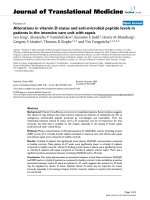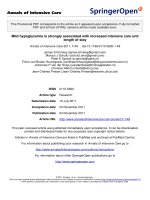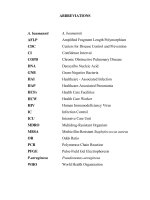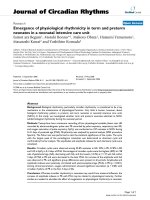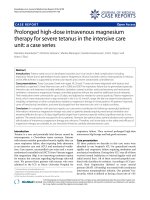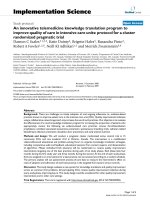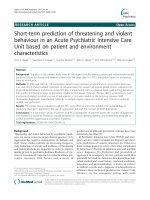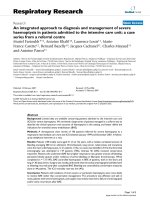ICU (Intensive care unit) protocol 2015
Bạn đang xem bản rút gọn của tài liệu. Xem và tải ngay bản đầy đủ của tài liệu tại đây (12.55 MB, 227 trang )
I
Introduction
There is growing interest in the use of evidence-based clinical practice guidelines as a means of reducing
inappropriate care, and making more effective use of health care resources. Moreover a standardized
approach to management is desirable for optimal patient care and safety, improving communication and
understanding between members of the ICU team and associated specialties.
Critical care protocols should be used as a roadmap for healthcare workers by providing guidance on what
is thought to be the best option regarding a specific aspect of care or the consensus on how a given situation
is usually best tackled. But they CAN NOT and SHOULD NOT be used in an attempt to replace expert
decision-making which weighs up all the aspects of each individual situation.
In the current version of ICU protocols, the management of most frequent critically care problems are
illustrated in stepwise approach. More than 50 coloured-flowcharts and tables are added. Each topic ends
with a list of references to guide the readers about more resources on the web
Our goal in 185 New Emergency and Burn Hospital, is to provide the highest level of patient care, by
using Evidence-based medicine which joins experience-based practice in a multidisciplinary approach.
Ahmed Mukhtar
Professor of anesthesia and critical care
Cairo University
I
Table of contents
Admission & Discharge Protocol ..................................................................................................................... 1
Admission Criteria to Intensive Care Unit ................................................................................................... 1
Admission Criteria to Intermediate Care Unit ............................................................................................. 3
Discharge Criteria ........................................................................................................................................ 4
Plan upon admission of patient to ICU ........................................................................................................ 5
Transfer Protocol ............................................................................................................................................. 7
Trauma Protocol .............................................................................................................................................. 9
Resuscitation protocol in traumatic hemorrhagic shock .............................................................................. 10
General principle: ...................................................................................................................................... 10
Fluid resuscitation...................................................................................................................................... 10
Traumatic Brain Injury ................................................................................................................................... 14
General principle ....................................................................................................................................... 14
Resuscitation and basic physiologic goals ................................................................................................. 14
Intracranial Pressure (ICP) Monitoring ...................................................................................................... 15
Adjunctive Medication and prevention of complication ........................................................................... 17
Metabolic Monitoring ................................................................................................................................ 18
Nutritional Support .................................................................................................................................... 18
NON-Emergency Surgery ........................................................................................................................... 19
SURGICAL MANAGEMENT OF TBI .............................................................................................................. 19
Acute Spinal Cord Injury ................................................................................................................................ 21
Hemodynamic Assessment of Patients with Circulatory failure ................................................................... 23
Sepsis Management Protocol........................................................................................................................ 30
General principles ...................................................................................................................................... 30
Sepsis Protocol........................................................................................................................................... 30
Vasopressors .............................................................................................................................................. 32
Sepsis screening tools ................................................................................................................................ 33
Fever Assessment .......................................................................................................................................... 37
Basic principle ............................................................................................................................................ 37
II
Infectious causes of fever .......................................................................................................................... 37
Non-Infectious causes of fever .................................................................................................................. 37
Evaluation of new fever in ICU (See algorithm below).............................................................................. 38
Nosocomial Infection .................................................................................................................................... 42
Hospital acquired and Ventilator Associated Pneumonia ......................................................................... 42
Community Acquired Pneumonia ............................................................................................................. 44
Community Acquired abdominal infection ............................................................................................... 45
Health Care Associated abdominal infection ............................................................................................ 46
Catheter related blood stream infection (CLBSI)....................................................................................... 48
Invasive candidiasis in ICU ......................................................................................................................... 51
Specific Types of infections ....................................................................................................................... 55
Multi-drug resistant gram negative bacteria (MDR-GNB) ......................................................................... 60
Mechanical Ventilation Protocol ................................................................................................................... 64
Parameters for institution of ventilation .................................................................................................... 64
Principles in optimizing ventilation in ICU patients .................................................................................... 64
Low tidal volume Ventilation ..................................................................................................................... 65
Strategies to improve severe hypoxemia .................................................................................................. 65
Weaning of Mechanical ventilation .............................................................................................................. 72
Important definitions................................................................................................................................. 72
Risk factors of extubation failure .............................................................................................................. 72
Assessment of readiness to wean ............................................................................................................. 72
Spontaneous breathing trial ...................................................................................................................... 73
Extubation .................................................................................................................................................. 74
Weaning failure ......................................................................................................................................... 74
Non-invasive ventilation protocol ................................................................................................................. 78
Indications of NIV....................................................................................................................................... 78
Specific indication of NIV ........................................................................................................................... 78
Contraindication of NIV ............................................................................................................................. 79
Initiation and titration of therapy.............................................................................................................. 79
III
Oral feeding and nutrition during NIV ....................................................................................................... 79
Nutrition Protocol.......................................................................................................................................... 82
Estimation of Nutritional Requirement ..................................................................................................... 83
Enteral Feeding .......................................................................................................................................... 85
Parenteral Nutrition................................................................................................................................... 86
Nutrition therapy in special population .................................................................................................... 87
Prophylaxis of Deep Venous Thrombosis ...................................................................................................... 89
General Principles ...................................................................................................................................... 89
Clinical risk factors for thromboembolism in critically ill patients ............................................................ 89
Risk factors of bleeding.............................................................................................................................. 89
Protocol of thromboembolism prophylaxis .............................................................................................. 89
Pharmacological prophylaxis ..................................................................................................................... 90
Management of Acute Pulmonary Embolism ............................................................................................... 94
Clinical classification of pulmonary embolism .......................................................................................... 94
Diagnostic strategies.................................................................................................................................. 94
Treatment in acute phase .......................................................................................................................... 94
Fluid Therapy And Electrolyte Replacement Protocol ................................................................................ 103
Electrolyte Replacement Protocol ........................................................................................................... 105
Hyponatremia .......................................................................................................................................... 108
Burn Resuscitation....................................................................................................................................... 113
General Rules ........................................................................................................................................... 113
Resuscitation guidelines .......................................................................................................................... 113
Stress Ulcer Prophylaxis (SUP) .................................................................................................................... 116
General Rules ........................................................................................................................................... 116
Stress ulcer prophylaxis protocol ............................................................................................................ 116
Gastro-intestinal hemorrhage protocol ...................................................................................................... 120
General principles .................................................................................................................................... 120
Initial Evaluation and Resuscitation......................................................................................................... 120
Find etiology and stratify risk .................................................................................................................. 120
IV
Send investigations .................................................................................................................................. 121
General treatment ................................................................................................................................... 121
Specific treatment ................................................................................................................................... 121
Management of DKA ................................................................................................................................... 125
Acid-Base protocol ...................................................................................................................................... 126
Acidosis .................................................................................................................................................... 127
Alkalosis ................................................................................................................................................... 128
Transfusion and Coagulopathy Management protocol .............................................................................. 130
Management of anemia and red cell transfusion ................................................................................... 130
Management of coagulopathy ................................................................................................................ 133
Disseminated intravascular coagulopathy .............................................................................................. 133
Cardiopulmonary resuscitation ................................................................................................................... 136
Electric cardioversion .......................................................................................................................... 141
Energy level of cardioversion .................................................................................................................. 141
Post-Return of Spontaneous Circulation (ROSC) ........................................................................... 143
Procedures ............................................................................................................................................... 143
Ventilation ............................................................................................................................................... 143
Hemodynamic Goals ................................................................................................................................ 143
Sedation & Pain Control .......................................................................................................................... 144
Lab & Electrolyte...................................................................................................................................... 144
DVT Prophylaxis ....................................................................................................................................... 144
Stress Ulcer Prophylaxis........................................................................................................................... 144
VAP Prophylaxis ....................................................................................................................................... 144
Induced Hypothermia Protocol ............................................................................................................... 144
Postoperative atrial fibrillation (AF) ............................................................................................................ 149
General principles: ................................................................................................................................... 149
Choice of Anticoagulant in patient wit AF ............................................................................................... 151
Recommendations for prevention of thromboembolism in non-valvular AF ......................................... 152
Acute Coronary Syndrome .......................................................................................................................... 154
V
Pediatric critical care ................................................................................................................................... 157
Pediatric Sepsis & septic shock Resuscitation Management .................................................................. 157
General Principles: ................................................................................................................................... 157
Definitions:............................................................................................................................................... 157
Sepsis Protocol:........................................................................................................................................ 160
Nutrition .................................................................................................................................................. 166
Nutrition screening .................................................................................................................................. 166
Determining Calorie and Protein Needs in Critically Ill Children ............................................................. 166
Enteral nutrition in ICU ............................................................................................................................ 167
Parenteral nutrition (PN) in ICU............................................................................................................... 170
Mechanical ventilation ............................................................................................................................ 174
Acute respiratory distress syndrome in pediatrics .................................................................................. 175
General principles .................................................................................................................................... 175
Clinical Management strategy ................................................................................................................. 175
Weaning of mechanical ventilation in pediatrics .................................................................................... 178
Obstetrics critical care ................................................................................................................................. 181
General principles .................................................................................................................................... 181
Respiratory distress in pregnant patient ................................................................................................. 181
Hemodynamic instability ......................................................................................................................... 181
Altered mental status/neurological abnormalities ................................................................................. 182
Pre-eclampsia .......................................................................................................................................... 184
Peripartum cardiomyopathy ................................................................................................................... 188
Hemorrhage during pregnancy ............................................................................................................... 191
Trauma In Pregnancy ............................................................................................................................... 193
Cardiac Arrest during pregnancy ............................................................................................................. 196
Pharmacotherapy ........................................................................................................................................ 199
Anticoagulant ........................................................................................................................................... 199
Heparin Infusion ...................................................................................................................................... 199
Warfarin Dosage ...................................................................................................................................... 200
VI
Anticoagulant reversal ............................................................................................................................. 203
New Oral Anticoagulants (NOACs) .......................................................................................................... 206
Antimicrobial dosing in renal insufficiency.............................................................................................. 211
Intravenous drug compatibility ............................................................................................................... 216
Pediatric drug infusion............................................................................................................................. 218
VII
Admission & Discharge Protocol
Admission Criteria to Intensive Care Unit
Criteria for admission to Intensive Care
1) Trauma patients
a. Injuries
i. Multisystem trauma
ii. Severe traumatic brain injuries (GCS<8)
iii. Cervical spine cord injury
iv. Severe pulmonary contusion, flail chest
v. Facial or neck trauma with threatened airway
vi. Repaired major vascular injuries
vii. Pelvic fracture with retroperitoneal hematoma
viii. Blunt cardiac trauma with hypotension or dysrhythmia
ix. Severe burn (20% TBSA, facial burns)
x. Isolated high grade solid organ injuries (grade III, IV)
b. Problems
i. Respiratory failure requiring mechanical ventilation
ii. Ongoing shock or hemodynamic instability
iii. \Massive blood or fluid resuscitation
iv. Base deficit >5
v. Hypothermia
vi. Seizures
vii. Pregnancy
2) Post-operative monitoring
a. Neurosurgery
b. major vascular surgery
c. Long surgical or interventional procedures
d. massive blood loss
1
e. Multiple co-morbidities with low systemic reserve)
3) Postoperative complications:
a. Acute respiratory failure requiring Invasive or non-invasive ventilation.
b. Optimization of fluid balance requiring invasive procedures
c. Hemodynamic instability requiring inotropic support
d. Potential for deterioration (e.g. airway swelling, metabolic disorders,
coagulopathies, hypoxaemia, hypercarbia, hypovolaemia, intracranial events).
e. Sepsis with multi-organ dysfunction.
f. Interventions that cannot be performed in a general ward –continuous venovenous hemofiltration
4) Preoperative optimization of patients with hemodynamic instability and/or major fluid
and electrolyte disturbance
5) Severe acute pancreatitis
2
Admission Criteria to Intermediate Care Unit
Criteria for admission to Intermediate care
1) Acute traumatic brain injury patients who have a Glasgow Coma Scale above 9 but
require frequent monitoring for signs of neurologic deterioration
2) Stable cervical spinal cord injured patients
3) The postoperative patient who, following major surgery, is hemodynamically stable but
may require fluid resuscitation and transfusion due to major fluid shifts
4) Appropriately treated and resolving early sepsis without evidence of shock or
secondaryorgan failure
5) Hemodynamically stable patients with evidence of compromised gas exchange and
underlying disease with the potential for worsening respiratory insufficiency who
require frequent observation
6) Diabetic ketoacidosis patients requiring constant intravenous infusion of insulin, or
frequent injections of regular insulin during the early
3
Discharge Criteria
Criteria for discharge from Intensive care unit to ward
1) Patient not on any support or intervention (or unlikely to need them in the next 24
hours) that cannot be provided in the ward. This includes equipment and nurse staffing
issues.
2) Low likelihood of deterioration in the next 24 hours. For long-stay patients and those
with low systemic reserve, the duration should be extended to 48 hours or more.
3) Supplemental inspired oxygen concentration <50%
4) Hemodynamically stable; any fluid losses should be at a rate manageable in the ward
environment
5) Cardiac dysrhythmias are controlled
6) The admission etiological factor is under control or not significant any more
7) Patients in whom treatment has been withdrawn and only need basic nursing care and
drugs for comfort
4
Plan upon admission of patient to ICU
Arrival To ICU
History and Physical Exam
Review old charts
Laboratory data
Radiological data
Define Reason for
admission
Define goal for ICU care
Follow ACLS protocol
ABC
Data Collection
Plan
Assess needs for ventilator support
Hemodynamic monitoring
Urgent Consultation
General
Specific Care
Critical care staff
Family
Nurse
Pharmacy
Call assistant lecture
for any change in
patient condition
Stable medical condition
Inform in charge nurse
Communicate with
receiving team
Inform patient and family
Admission Order
Communication:
The most overlooked
aspect of patient care
Daily Review
Discharge
Planning
5
DVT prophylaxis
GI prophylaxis
Sedation/paralysis
Nutrition
Fluid replacement
Skin Care
Hemodynamic
parameter
Ventilatory parameter
Weaning Potential
Sedation regimen
Need for radiological
procedure
Electrolyte
Fluid Balance
Nutrition
Renal Function
Lines
Adverse drug reaction
Communication
References
1. Department of Health Working Group. Guidelines on Admission to and Discharge from Intensive Care
and High Dependency Care Units. London:Department of Health. (1996)
2. Daly K, Beale R, Chang S Reduction in mortality after inappropriate early discharge from intensive
care unit: logistic regression triage model. Br. Med. J. 2001, 322:1274
6
Transfer Protocol
Airway
Circulation
Patients with (or at risk from) airway
Adequate intravenous access
compromise should be intubated prior to
Circulating volume optimized
transfer
Hemodynamically stable
The tracheal tube should be secured and
All lines are patent and secured
confirmed in correct position
Any active bleeding controlled
Long bone/pelvic fractures stabilized
ECG and blood pressure monitored
C. Spine
Disability
Adequate spinal immobilization (if indicated)
No active seizures
Initial treatments for raised intracranial
pressure (if indicated)
Life-threatening electrolyte disturbances
corrected
Breathing
Patient adequately sedated if ventilated
Ventilation established (and stable) on
Blood glucose >70 mg/dl
Exposure
Patient adequately covered to prevent heat
loss
transport ventilator
Adequate gas exchange on transport
ventilator confirmed by arterial blood gas
analysis
Adequate oxygen supply on transfer vehicle
7
References
1. Intensive Care Society Guidelines for the Transport of the Critically Ill Adult, 2nd edn.
London:Intensive Care Society (UK). 2002
8
Trauma Protocol
Figure 1: Initial Trauma management
9
Resuscitation protocol in traumatic hemorrhagic shock
General principle:
Traumatic death is the main cause of life years lost worldwide. Hemorrhage is responsible for
almost 50% of deaths in the first 24 h after trauma.
The optimal resuscitative strategy is controversial: choice of fluid for resuscitation, the target of
hemodynamic goals for hemorrhage control, and the optimal prevention of traumatic
coagulopathy are questions that remain.
Fluid resuscitation
I. Type of fluid
Lactated Ringer’s solution is recommended as first-line resuscitation fluid in trauma patients
Albumin should be avoided in patients with TBI
In patients with TBI, isotonic saline should be preferred over hypotonic fluids because it can
reduce the risk of cerebral edema.
II. Endpoints of resuscitation
Three different target systolic blood pressure values can be considered for three different
traumatic conditions before controlling source of hemorrhage:
o 60–70 mmHg for penetrating trauma
o 80–90 mmHg for blunt trauma without TBI
o 100–110 mmHg for blunt trauma with TBI
Lactate ≥ 2 mmol/L and base deficits ≥ -5 mEq/L have been demonstrated useful to stratify
patients who need a larger amount of fluid after the initial resuscitation.
III. Vasopressor
Early use of norepinephrine could limit fluid resuscitation and hemodilution.
The dose of norepinephrine should be titrated until we reach the target systolic blood pressure
as indicated above
IV. Transfusion and prevention of acute coagulopathy of trauma
The correction and prevention of traumatic coagulopathy have become central goals of early
resuscitative management of hemorrhagic shock.
a) Red blood cells
In patients without TBI: Target haemoglobin level (7-9 g/dL)
In patients with severe TBI (GCS ≤ 8): Target haemoglobin level ≥ 10 g/dL
a) Fresh Frozen Plasma (FFP)
In all patients FFP should be considered when PT or PTT ≥ 1.5 times normal value
10
The initial recommended dose of FFP is 10 to 15 ml/kg
b) Platelet
In patients without TBI: Platelet transfusion is recommended when platelet count ≤ 50.000/L
In patients with TBI: Platelet transfusion is recommended when platelet count ≤ 100.000/L
c) Fibrinogen
In all patients, fibrinogen level should be maintained ≥ 150-200 mg/dL
The use of FFP failed to rapidly correct the hypofibrinogenemia
o Resuscitation with 10 to 15 mL/kg of FFP only increased the fibrinogen plasma level to 40
mg/dL
o More than 30 mL.kg of FPP should be necessary to increase the fibrinogen plasma level to
100 mg/dL
10 single bags of cryoprecipitate derived from whole blood are needed to raise the plasma
fibrinogen level by 100 mg/dL
d) Adjuvant Therapy
I.
Tranxemic acid: routine administration of tranexamic acid (loading dose of 1 g over 10 min,
then infusion of 1g over 8 hr) in patients with hemorrhagic shock was associated with a
decreased mortality rate.
II.
Factor VIIa: No clear recommendation to use activate factor VII and the use of this factor
should be discussed on a case-by-case basis.
III.
Ionized calcium level should be maintained between 1.1-1.3 mmol/L
11
Figure 2: initial management of traumatic hemorrhagic shock
12
(1)
References
1. Bouglé A, Harrois A, Duranteau J. Resuscitative strategies in traumatic hemorrhagic shock. Ann
Intensive Care. 2013; 12:1
13
Traumatic Brain Injury
General principle
Traumatic brain injury (TBI) is a serious public health problem in Egypt, contributing to over 50%
of trauma deaths
Protocolized management of severe TBI [defined as a post-resuscitation Glasgow Coma Score
(GCS) < 8] has been demonstrated to improve patient outcome
Protocol for management of TBI is based on management guidelines proposed by PROTECT III trial
Resuscitation and basic physiologic goals
A. Airway management
Patients with a GCS ≤ 8 should be intubated for airway protection
Sedative and analgesic choices should include short acting agents through the initial resuscitation,
as temporal assessment of neurological status is critical
o Propofol is strongly recommended as the choice for sedation,
o Succinylcholine, Rocuronium bromide – paralytic for induction
B. Oxygenation/Ventilation
The Target Oxygen status is PaO2 ≥ 100 mmHg and O2 Sat ≥ 90%
Avoidance of hypoxia
o Patients with moderate TBI who do not require intubation should have pulse oximetry
maintained to at least 90%.
o Intubated patients PaO2 should be maintained at ≥ 100 mmHg, except during weaning.
Pulse oximetry > 90 % remains goal during ventilation wean
Ventilation
o Hyperventilation should be intensively avoided during the initial resuscitation
o The Target PaCO2 is (35-45 mmHg)
o Prophylactic hyperventilation (PaCO2 < 35 mmHg) is prohibited.
o Therapeutic hyperventilation may be necessary for brief periods when there is acute
neurological deterioration that coincides with a cerebral herniation syndrome or for
refractory elevations in ICP
C. Blood Pressure, Volume Resuscitation, Anemia, and Coagulopathy
Blood Pressure
o A systolic blood pressure (SBP) should be kept between 100 mmHg and 180 mmHg.
Recognize that lower blood pressures can represent a “relative” hypotensive state in TBI
patients (especially with elevated ICP)
14
o Normal Saline Fluid should be used as the initial method of maintaining euvolemia to
achieve the target blood pressure.
o Assessment for transfusion and/or implementation of vasoactive drugs should be
considered for treatment of hypotension. Such Vasopressors or Inotrops include
Phenylephrine (Neosynephrine), Levophed, Epinephrine, Dobutamine, and Vasopressin.
Euvolemia – The primary target is euvolemia.
o In many cases a central venous pressure (CVP) monitor will be placed. A CVP goal of 5-7
mmHg correlates with euvolemia, but should be assessed in the context of the individual
patient’s clinical picture. CVP or other types of invasive monitoring are recommended in
patients with severe TBI requiring ventriculostomy or intubation.
o Brain-injured patients should be maintained in a euvolemic state with volume replacement
of blood products and crystalloid.
o The initial resuscitation fluid should be normal saline. Hypertonic saline should only be
used as a secondary osmotic agent in ICP control.
o Volume resuscitation to achieve euvolemia should NOT be withheld to prevent concerns
with cerebral edema.
o Conversely, hypervolemia should be avoided as it is associated with increased incidence of
ARDS in TBI patients.
Anemia - The target is to keep hemoglobin concentration at 8 g/dl or above.
o The hemoglobin concentration (Hgb) of the patient should be maintained at ≥ 8 g/dL
o Blood should be transfused for Hg < 8 g/dL.
Coagulation – Coagulation panels should be followed closely.
o The Target INR is less than or equal to 1.4
o FFP, Vitamin K, Factor VII, should be administered, as clinically indicated, in order to
correct coagulopathy.
o INR and platelet count should be corrected in anticipation of placement of
ventriculostomy, or other intracranial surgery.
o Platelets should be transfused for a platelet count < 75 x 103 / mm3.
Intracranial Pressure (ICP) Monitoring
All patients with signs and symptoms of increased intracranial pressure (ICP) and/or GCS ≤ 8
should receive a ventriculostomy for ICP monitoring (unless there is a direct contraindication to
invasive monitoring, such as INR >1.4 or platelet count of <75 x 103
Indications
o Salvageable patients with severe TBI (GCS 3-8 after resuscitation) and an abnormal CT scan
(hemorrhage, contusions, swelling, herniation or compressed basal cisterns)
o Patients with severe TBI and normal CT scan if two of the following are noted at admission:
age > 40 yrs, unilateral or bilateral posturing, systolic BP < 90 mmHg
15
Management of increased ICP
o General recommendation
Ventilation – Keep O2 Sat >90, and PaO2>100, and PCO2 = 35-45.
Monitor Systolic BP and MAP - avoid hypotension, Systolic >100 mmHg.
Normothermia goal <38.3°C: treat fever with acetaminophen and/or cooling
blankets.
Adjust cervical collar placement if applicable.
Consider repeat CT: a repeat CT scan of the brain should be considered to rule out
the development of a surgical mass or unexpected intracranial lesion
o TIER 1
Head of patient’s bed to be placed at ≥ 30 degrees.
Sedation and analgesia using recommended agents (propofol, fentanyl, and versed)
in intubated patients. Pain relief and sedation are appropriate initial modalities for
treatment of intracranial hypertension.
Ventriculostomy - extraventricular drain; drain to 10 cmH2O for ICP ≥ 20 mmHg
sustained for ≥ 5min
Mannitol – 0.25-1.0g/kg; IV bolus x 1 dose
Tier 1 completed within 120 minutes, if ICP ≥ 20 mmHg/27.2 cm H20 mmHg proceed to Tier
2
o TIER 2
Hyperosmolar therapy
Mannitol: intermittent boluses of mannitol (0.25 - 1 gm/kg body weight)
should be administered.
Hypertonic saline: boluses of 3% sodium chloride solution (250 cc over ½
hour)
Measure serum osmolality and electrolytes q 12 hrs
Hold hypertonic saline therapy for serum Na > 160 mEq/L
Hold mannitol therapy for serum osmolality > 320 mOsm
Protect the Brain
Initiate continuous EEG monitoring to rule non-convulsive status
epilepticus
Provide judicious analgesia and sedation to control pain and agitation
Fentanyl 25-150 mcg/hr IV infusion
Propofol 10-50 mcg/kg/hr IV infusion for Richmond Agitation
Sedation Score (RASS) > -2
Tier II completed within 120 minutes, if ICP ≥ 20 cmH20/mmHg proceed to Tier 3.
16
TIER 3
Decompressive hemi-craniectomy or bilateral craniectomy should only be
performed if Tiers 1 and 2 are not sufficient.
Barbiturate
Pentobarbital 10 mg/kg IV over 10 minutes, then 5 mg/kg IV q 1 hr x 3, then
1 mg/kg/hr IV infusion
Titrate pentobarbital to the minimal dose required to achieve EEG burst
suppression
Discontinue all other sedative agents and paralytics
Adjunctive Medication and prevention of complication
A. Antiseizure Prophylaxis
Post traumatic seizures are a recognised complication of closed head injuries with incidence
depending largely on severity of injury.
Post traumatic seizures are classified as either
o Immediate, early (0-7 days) or
o Late/delayed (>7 days)
Anti-convulsants are therefore only indicated in the first week following closed head injury to
reduce the risk of complications from early post traumatic seizures. They should not be
routinely continued long term.
The following CT scan findings may indicate the need for late PTS prophylaxis (anticonvulsant
therapy for longer than 7 days post injury) (1):
o Biparietal contusions.
o Dural penetration with bone and metal fragments.
o Multiple intracranial operations.
o Multiple subcortical contusions.
o Subdural hematoma with evacuation.
o Midline shift greater than 5mm.
o Multiple or bilateral cortical contusions.
Anticonvulsant drugs
o Phenytoin is effective in decreasing the risk of early PTS in patients with severe TBI.
Dose: phenytoin is administered intravenously with a loading dose of 17 mg/kg
intravenous infusion over 30-60 minutes, followed by a maintenance dose of 100
mg given three times daily, either intravenously or orally for a total of seven days.
Valproate should NOT be used for early PTS prophylaxis.
Levetiracetam is an effective and safe alternative to phenytoin for early PTS
prophylaxis.
17
